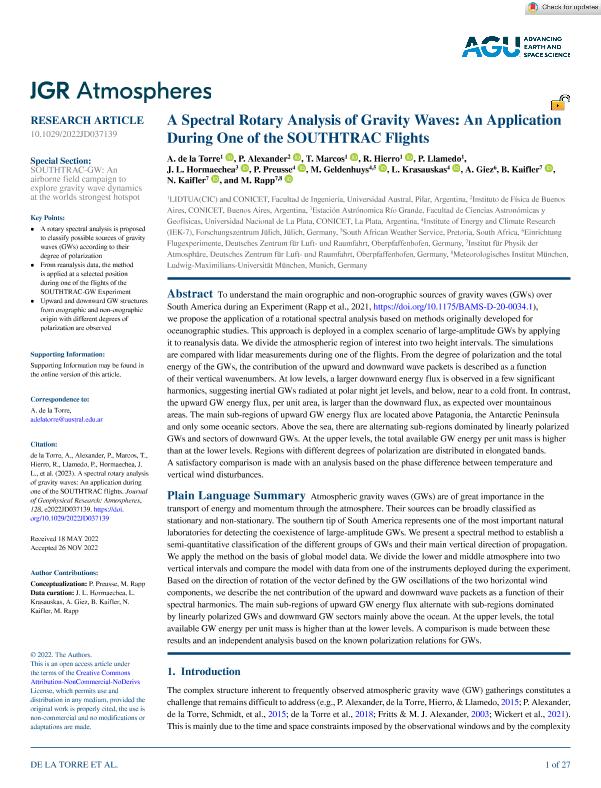Mostrar el registro sencillo del ítem
dc.contributor.author
de la Torre, Alejandro

dc.contributor.author
Alexander, Pedro Manfredo

dc.contributor.author
Marcos, Tomas

dc.contributor.author
Hierro, Rodrigo Federico

dc.contributor.author
Llamedo Soria, Pablo Martin

dc.contributor.author
Hormaechea, José Luis

dc.contributor.author
Preusse, P.
dc.contributor.author
Geldenhuys, M.
dc.contributor.author
Krasauskas, L.
dc.contributor.author
Giez, A.
dc.contributor.author
Kaifler, B.
dc.contributor.author
Kaifler, N.
dc.contributor.author
Rapp, M.
dc.date.available
2023-12-11T15:47:50Z
dc.date.issued
2023-01
dc.identifier.citation
de la Torre, Alejandro; Alexander, Pedro Manfredo; Marcos, Tomas; Hierro, Rodrigo Federico; Llamedo Soria, Pablo Martin; et al.; A Spectral Rotary Analysis of Gravity Waves: An Application During One of the SOUTHTRAC Flights; John Wiley & Sons; Journal of Geophysical Research: Atmospheres; 128; 1; 1-2023; 1-27
dc.identifier.issn
2169-897X
dc.identifier.uri
http://hdl.handle.net/11336/219823
dc.description.abstract
To understand the main orographic and non-orographic sources of gravity waves (GWs) over South America during an Experiment (Rapp et al., 2021, https://doi.org/10.1175/BAMS-D-20-0034.1), we propose the application of a rotational spectral analysis based on methods originally developed for oceanographic studies. This approach is deployed in a complex scenario of large-amplitude GWs by applying it to reanalysis data. We divide the atmospheric region of interest into two height intervals. The simulations are compared with lidar measurements during one of the flights. From the degree of polarization and the total energy of the GWs, the contribution of the upward and downward wave packets is described as a function of their vertical wavenumbers. At low levels, a larger downward energy flux is observed in a few significant harmonics, suggesting inertial GWs radiated at polar night jet levels, and below, near to a cold front. In contrast, the upward GW energy flux, per unit area, is larger than the downward flux, as expected over mountainous areas. The main sub-regions of upward GW energy flux are located above Patagonia, the Antarctic Peninsula and only some oceanic sectors. Above the sea, there are alternating sub-regions dominated by linearly polarized GWs and sectors of downward GWs. At the upper levels, the total available GW energy per unit mass is higher than at the lower levels. Regions with different degrees of polarization are distributed in elongated bands. A satisfactory comparison is made with an analysis based on the phase difference between temperature and vertical wind disturbances.
dc.format
application/pdf
dc.language.iso
eng
dc.publisher
John Wiley & Sons

dc.rights
info:eu-repo/semantics/openAccess
dc.rights.uri
https://creativecommons.org/licenses/by-nc-nd/2.5/ar/
dc.subject
ANTARCTIC PENINSULA
dc.subject
ENERGY FLUX
dc.subject
GRAVITY WAVES
dc.subject
PATAGONIA
dc.subject
ROTARY SPECTRUM
dc.subject
SOUTHTRAC
dc.subject.classification
Meteorología y Ciencias Atmosféricas

dc.subject.classification
Ciencias de la Tierra y relacionadas con el Medio Ambiente

dc.subject.classification
CIENCIAS NATURALES Y EXACTAS

dc.title
A Spectral Rotary Analysis of Gravity Waves: An Application During One of the SOUTHTRAC Flights
dc.type
info:eu-repo/semantics/article
dc.type
info:ar-repo/semantics/artículo
dc.type
info:eu-repo/semantics/publishedVersion
dc.date.updated
2023-12-07T17:50:05Z
dc.identifier.eissn
2169-8996
dc.journal.volume
128
dc.journal.number
1
dc.journal.pagination
1-27
dc.journal.pais
Estados Unidos

dc.description.fil
Fil: de la Torre, Alejandro. Consejo Nacional de Investigaciones Científicas y Técnicas; Argentina. Universidad Austral; Argentina
dc.description.fil
Fil: Alexander, Pedro Manfredo. Consejo Nacional de Investigaciones Científicas y Técnicas. Oficina de Coordinación Administrativa Ciudad Universitaria. Instituto de Física de Buenos Aires. Universidad de Buenos Aires. Facultad de Ciencias Exactas y Naturales. Instituto de Física de Buenos Aires; Argentina
dc.description.fil
Fil: Marcos, Tomas. Universidad Austral; Argentina
dc.description.fil
Fil: Hierro, Rodrigo Federico. Universidad Austral; Argentina
dc.description.fil
Fil: Llamedo Soria, Pablo Martin. Consejo Nacional de Investigaciones Científicas y Técnicas; Argentina. Universidad Austral; Argentina
dc.description.fil
Fil: Hormaechea, José Luis. Consejo Nacional de Investigaciones Científicas y Técnicas; Argentina. Universidad Nacional de La Plata. Facultad de Ciencias Astronómicas y Geofísicas; Argentina
dc.description.fil
Fil: Preusse, P.. Helmholtz Gemeinschaft. Forschungszentrum Jülich; Alemania
dc.description.fil
Fil: Geldenhuys, M.. Helmholtz Gemeinschaft. Forschungszentrum Jülich; Alemania. South African Weather Service; Sudáfrica
dc.description.fil
Fil: Krasauskas, L.. Helmholtz Gemeinschaft. Forschungszentrum Jülich; Alemania
dc.description.fil
Fil: Giez, A.. Deutsches Zentrum für Luft- und Raumfahrt; Alemania
dc.description.fil
Fil: Kaifler, B.. Deutsches Zentrum für Luft- und Raumfahrt; Alemania
dc.description.fil
Fil: Kaifler, N.. Deutsches Zentrum für Luft- und Raumfahrt; Alemania
dc.description.fil
Fil: Rapp, M.. Deutsches Zentrum für Luft- und Raumfahrt; Alemania. Ludwig Maximilians Universitat; Alemania
dc.journal.title
Journal of Geophysical Research: Atmospheres
dc.relation.alternativeid
info:eu-repo/semantics/altIdentifier/url/https://agupubs.onlinelibrary.wiley.com/doi/10.1029/2022JD037139
dc.relation.alternativeid
info:eu-repo/semantics/altIdentifier/doi/http://dx.doi.org/10.1029/2022JD037139
Archivos asociados
